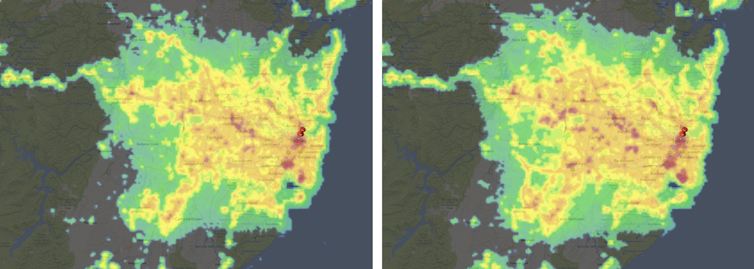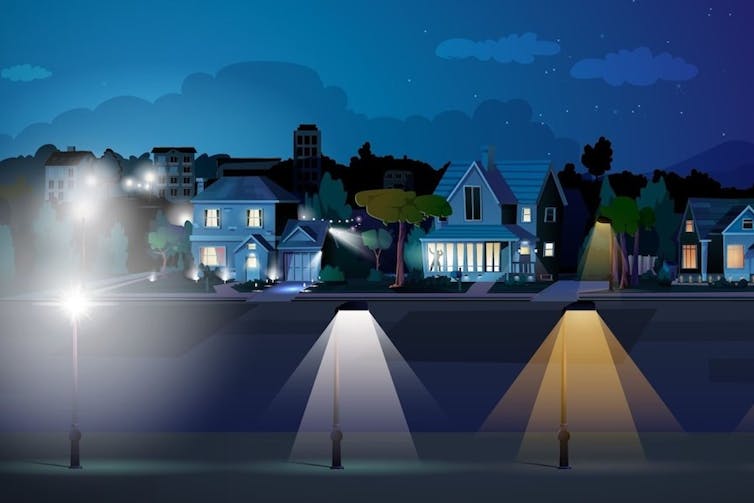By Brad E Tucker, Australian National University
For the more than 100,000 years humans have been on Earth, we have looked up at night and seen the stars and our celestial home, the Milky Way galaxy. Cultures all around the world have stories and records incorporating this majestic, sublime sight.
However, nearly 3 billion people can no longer see the Milky Way when they look skyward at night. In turn, their connection to the cosmos – and to the sense of deep time it represents – has also been lost.
Light pollution is the culprit of this loss. But it is a relatively recent problem. In fact, roughly a century ago, the skies above some of even the biggest cities in the world were still dark enough to see the gaseous clouds of the Milky Way and the infinite specks of flickering light shining in the farthest reaches of the universe.
So, what happened? And what can we do to help darkness reign supreme again?
The long legacy of lights
Light pollution is the spill or glow of lights upward, into the sky.
Lights help us see on the ground. But for a variety of reasons – from poor design to inefficient lights and unnecessary lighting – light pollution in an area can grow fast.
Light pollution also comes from a variety of sources.
Much of it comes from streetlights. They contribute 20% to 50% of the light pollution in a city. But they are not the only source. Others include floodlights from ovals, billboards and lights at our homes – both inside and outside.
At night, when we see a large building or empty apartment building with all the lights on inside and no shades or covers, that is light pollution.
A new problem
For thousands of years, humans have made detailed observations of the Milky Way – including even dark patches where dust blocks out starlight from behind.
For example, Aboriginal and Torres Strait Islander people in Australia have thorough records of the Great Celestial Emu. This is formed by the dark dust lanes in the Milky Way from right near the Southern Cross constellation, an area called the Coalsack Nebula.
Roughly a century ago you could see sublime sights such as this in the night sky while standing in the middle of the so-called “city of lights” – Paris.
In the late 1880s, through to the 1910s, French astronomer Guillaume Bigourdan observed many galaxies from the Paris observatory.
 The Paris Observatory in the beginning of the eighteenth century. Charles Wolf
The Paris Observatory in the beginning of the eighteenth century. Charles Wolf
In 1917, he said you could see the Milky Way from the Paris observatory during summer when the sun was sufficiently below the horizon, about the position of nautical twilight – the time of night where when at sea, you can no longer see the horizon.
But it was around this period that light pollution started to become a problem in modern cities.
The Melbourne Observatory was established in 1863 but stopped doing astronomy in the early 1900s. This was partly because light pollution from Melbourne was hindering astronomers’ ability to accurately observe the night sky.
In 1924, Mount Stromlo Observatory, located outside Canberra, took over observing the Milky Way. It was chosen for its remote location and dark skies.
However, by the 1950s, despite the Australian capital being less than 10% of its current size and having less than 10% of its current amount of light pollution, a new dark site needed to be found because the Milky Way was slowly being lost from sight. The site scientists chose was located eight hours away at Siding Spring Observatory.
However, even Siding Spring can now see the glow of Sydney – from 450 kilometres away.
 Satellite images of light pollution of Sydney from the VIIRS satellite from 2012 and 2022. The red areas are higher sources of light pollution. NOAA/VIIRS
Satellite images of light pollution of Sydney from the VIIRS satellite from 2012 and 2022. The red areas are higher sources of light pollution. NOAA/VIIRS
What can be done?
By living our modern lives more intelligently, the Milky Way could be visible again from anywhere, including the heart of Sydney, Paris or Los Angeles – just as it was 100 years ago.
Shielding of lights is an important aspect. Instead of having an open light, flat lights or shielded lights that prevent spill upward are crucial. They direct light to the ground, and not up into the sky.
In Canberra, the Australian Capital Territory government and light operator Omexom have been changing streetlights to do exactly this – no upward spill, and controllable lights.
 Different types of lights and how they can be improved. Omexom
Different types of lights and how they can be improved. Omexom
In doing so, Canberra has reduced its light pollution by about 30% in only a few years, as my colleagues and I report in a forthcoming paper.
Turning off – or dimming – unnecessary lights is also important.
Canberra is also doing this. It has been dimming street lights down to 50% of their total brightness in the middle of the night. In doing so, the city is saving energy – and reducing light pollution. For every 10% we dim streetlights, we reduce light pollution by 5%, as our forthcoming paper also finds.
The colour of light is another part of the solution. Instead of using bright white LEDs and cold-coloured lights, we can use warm-coloured lights, which are better for our eyes, sleep cycles, native animals – and for reducing light pollution.
With these simple measures, we can return to the not-so-long-ago time when we could see the Milky Way wherever we were standing on Earth.
We can regain the night sky.
This article is republished from The Conversation under a Creative Commons license. Read the original article.




